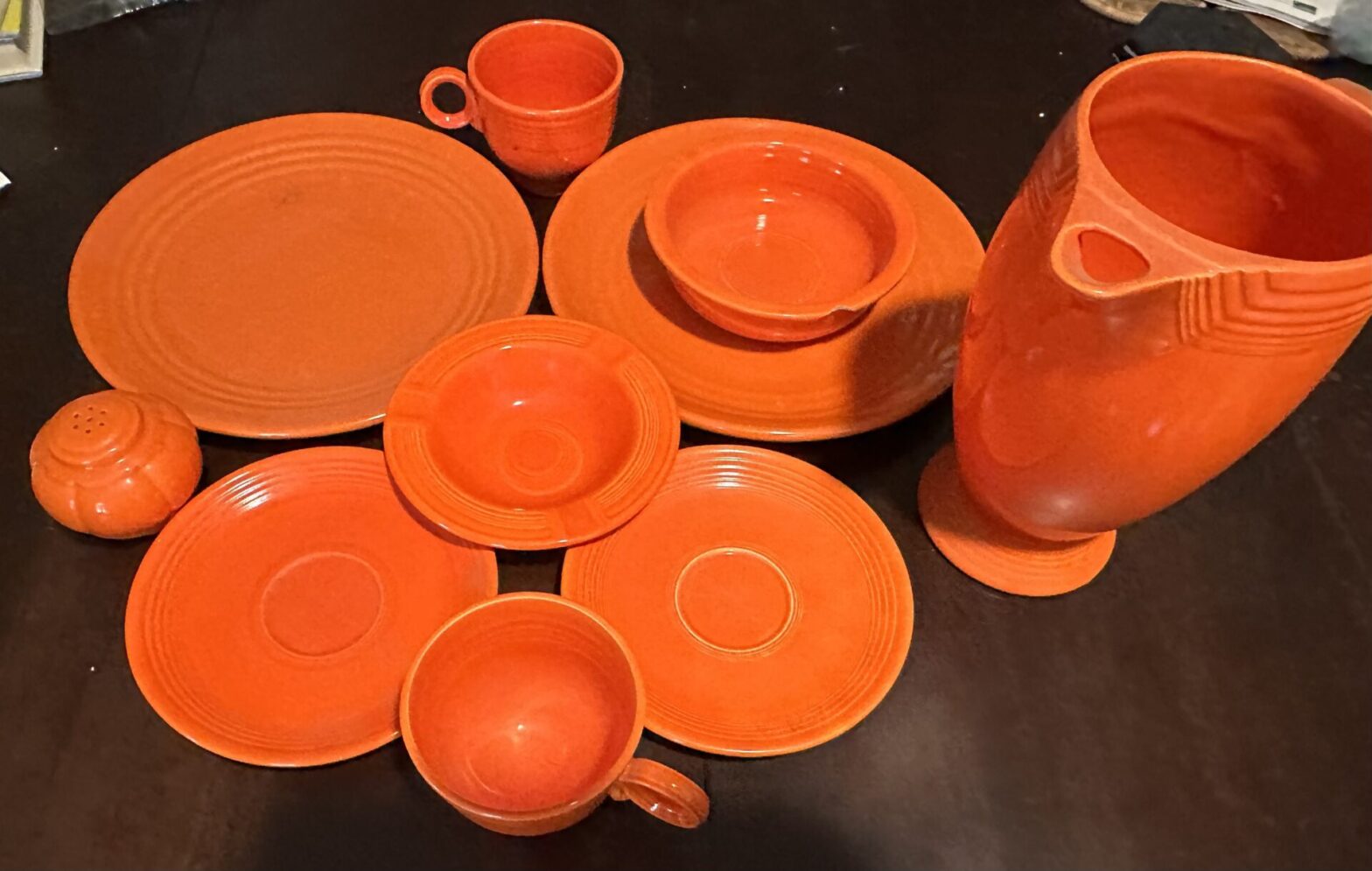Fine. FINE! After the who knows how manyeth time of being asked or having someone referred to me, I am writing this down for ease of reference to just point at.
TL;DR version – It’s perfectly safe to possess Fiestaware & uranium glass in your home and to consume food or drink that isn’t acidic with/from/on intact specimens. If you have broken glass or ceramics, you should throw that away because it’s sharp. It isn’t a problem to have large collections.
About Uranium
Right up front, I want to be crystal clear about this: while uranium is most definitely radioactive, uranium is not a radiotoxic substance. While easily detectable with meters, uranium doesn’t constitute an external radiation hazard. It’s not a problem for uranium to just be sitting there, but it is if you eat it or snort a whole bunch ground into a powder so don’t do that. For internal uptake of material, the amount of uranium you would need to consume before I’d have radiological concerns has a measurement unit of “rail cars”. You should instead always be much more worried about the heavy metals toxicity damage to the kidneys, liver, and marrow from ingestion and inhalation, with a similar low daily/annual uptake limits as lead & mercury, than anything radiological. You’ll be long dead of heavy metals poisoning before radiotoxicity is ever an issue. Even then, it needs to be bioavailable enough chemically to do that damage or you crap it right out. Actually, if you have uranium metal, be WAY more worried about pyrophoricity than anything else. As I’ve said before, fire is a way lower latency problem. In short, radiation-wise, uranium isn’t that scary.
For a little extra detail, one of the other questions that regularly comes up about uranium is “What kind of radiation does it emit?” If handed a lump of uranium ore, the answer is All Of Them because it has all of the naturally occurring isotopes and their decay chain daughters; alpha, beta, gamma and neutron though in very different abundances and biological consequence. The various extant terrestrial uranium radionuclides themselves are primarily alpha emitters. In a few special cases, like U-235, they can undergo spontaneous fission with neutron emissions, though this is vanishingly rare until you put enough of it in the same place to get some chain reactions (be sure you want that before you do it). But uranium never comes alone. Natural occurring uranium is in a state called “secular equilibrium” with all of its decay daughters, which are also radioactive, down to lead. Depleted uranium (AKA depU or DU) is made by first extracting uranium from all of its daughters in ore and then separating U-235 from the U-238; the leftover U-238 is “depleted in U-235”, hence the name depleted uranium. And even if you perfectly extract all uranium from ore, it immediately starts growing new daughters that emit a wide variety of alpha, beta, and gamma energies but it’ll take a while, about a million years, to get back to secular equilibrium.
For Manhattan Project related reasons, commercial items using uranium prior to 1940 have been made with natural uranium. After 1950, they’re mostly made with depleted uranium. The lesson here being it’s not waste if you can find someone to buy it.
But let’s go to the question that brings these items into people’s lives, thus scaring them with the DEADLY RADIATIONS. Why do ceramics glazes and glass exist that incorporate uranium? Why were they mass produced? ANSWER: Because they were pretty, durable, and cheap enough. But more importantly, uranium isn’t something new to our use in art and artifice. We didn’t isolate the specific element uranium from ore until 1789, but you are disrespecting our ancestors tremendously if you don’t give them credit for spotting a pigment they liked and could use. We didn’t have knowledge of the nature of radioactivity, and uranium having that property for all of its isotopes, until 1896. Discussed that a bit in this Choose Your Own Radiation Adventure. Because uranium is so versatile with plentiful oxidation states and many electrons to share in molecules, you can get a uranium based pigment in almost any color you like for your ceramics and glass, thought the most common on the market are orange and green, respectively. This usually results in people panicking that it isn’t okay to eat or drink off of uranium glass or uranium glaze ceramic, or even handle it, or even have it in your house due to radiophobia. Now that I told you about the heavy metals toxicity in paragraph three, maybe you’ll regard it in the same hazard class as pewterware or lead crystal. If so, fantastic, because that’s much more appropriate.
Uranium Glass
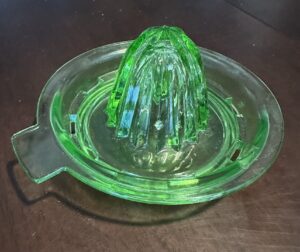
Let’s start with uranium glass, because that’s more or less the exact same as lead crystal glass, except you’re using uranium rather than lead to make that fine crystal. The difference is that, depending on how much uranium you throw into the mix, that crystal ends up being a transparent yellow to green colored glass (1-10% by weight) to an increasingly opaque mint green to milky white glass that looks like Vaseline, AKA vaseline glass. Some vaseline glass can be over 25% uranium by weight. Much like lead crystal, you don’t drink acidic things like wine or orange juice out of them as it leaches the metal out of the glass into your drink. Stick with nice neutral pH things like water or non-tiki drink cocktail. And for fuck’s sake, don’t drink grapefruit juice from great-grandma’s crystal either, ya dingus.
I wouldn’t think I’d need to say this but, if something tastes sour, it’s acidic.
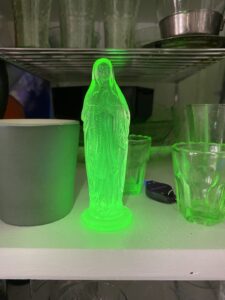
For completeness, uranium glass wasn’t limited to drinking vessels and food prep & storage, goodness no. Anything else you could do with normal glass is something you can do with uranium glass, which is to say so many functional household products, art objects, and jewelry. Sometimes that is the PERFECT green for your Tiffany piece. One of the hallmarks of uranium glass is that it fluoresces when exposed to ultraviolet light. Once again, please give our ancestors (even ones recent enough for you to have met) a little credit for not being all that different from us; if you have something that will glow weirdly in a dimly lit club with blacklights, we are gonna wear that shit to the club. We didn’t stop wearing uranium glass jewelry because everyone decided it was bad, but rather we developed the ability to make plastics loaded with other phosphors that glowed much better and in a variety of colors. The reason we don’t make many uranium glass objects anymore is that possessing the quantities of uranium to do it on an industrial scale gets you regulatory attention these days and the market demand just isn’t there to make it worth dealing with that. We don’t make nearly as many lead crystal things either. I blame plastics and organic chemists.
Fiestaware
Moving on from glass to ceramic glazes, which are a kind of glass if you’re inclined to think that way, I said the most common color was orange. Specifically, people associate uranium with the original red-orange glaze of the Homer Laughlin China Company’s simplified art deco line of ceramics called Fiestaware. The red-orange was part of the original 1936 color offerings and continued until 1972, with a bit of a hiatus from 1943-1959 because of the whole Manhattan Project and no one can have uranium but the federal government thing. While many collectors are interested in the shapes of the Fiestaware line, the red-orange was the most eye catching and popular color at the time (and still based on price variation between colors of the same design). When the product line was resurrected in 1986 for the 50th anniversary, the uranium based red-orange glaze did not return.
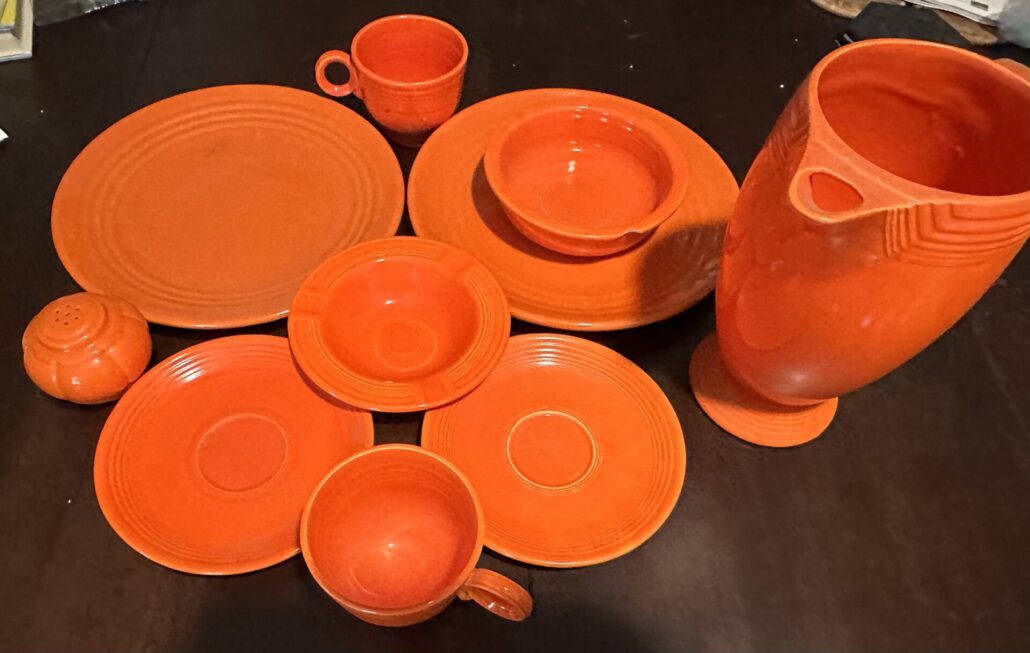
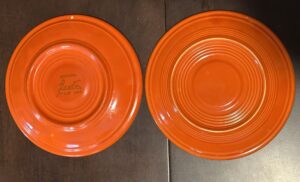
But, not to cause undue concern, Homer Laughlin was hardly the only company using uranium in their ceramic glaze. Fiestaware was not the first line of ceramics to incorporate uranium but their red-orange glaze was so popular that it attracted imitators, all of whom used varying levels of uranium content to try to hit that color. However, red-orange isn’t the only uranium glaze color. The next most common after the red-orange is black, then yellow, and then, well, every color. The weirdest uranium glaze color I’ve found so far is a kind of pastel lavender candy dish that definitely sets my meter off. A predecessor and competitor of Fiestaware was the Bauer Company of Pasadena, CA who began operation in 1909 and using uranium glazes. While they didn’t use the term “Bauerware” to describe their items, the collector market does and some of their black glazes have a considerably thicker and higher uranium content than Fiestaware red-orange. If you are Fiestaware collector, you’re gonna insist on that stamp on the underside of the item which you can see on the left-hand plate in the picture; if you just need a check source for your rad meter that’s a commercial product so you won’t get hassled by the TSA, you just need uranium content and don’t need to be that picky. Just to be complicated, not all Fiestaware items got the stamp on them because of course they didn’t, why make a collector’s life easy?
Eating food off of Fiestaware and imitators does not mean you’re consuming uranium. Ceramic glazes are remarkably durable and, unless you make a habit of using diamond edged utensils, you won’t be abrading that glaze in any way that you’d be consuming it. Much like uranium glass, acidic foods can leach uranium out of the glaze but that’s a less convincing scenario that people drinking wine from uranium & lead crystal. If you break the ceramic and turn it to a powder, yes, the uranium would be available to you for uptake but I have to ask serious questions about why you are snorting and/or eating sand. Do you have someone that looks after you and should I have a word with them?
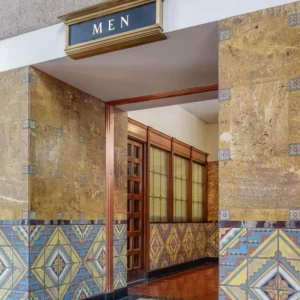
The question I usually get asked, with a radiophobic edge to it, is “Why would people use uranium in Fiestaware AT ALL?” Like I said back in paragraph six, please give our ancestors some respect for recognizing a pretty color and the stuff that makes it, even if they didn’t specifically know what uranium was. We are no different than our ancestors in liking pretty things though our taste in fashion & style spins a bit faster. Ever since the 1986 relaunch of the Fiestaware line, people have lamented the lack of red-orange and that every attempt to get something close just isn’t quite right. This is where I’ll encourage you to think about all the gorgeous “southwest style” ceramic decorative tiles that were so popular from the 1910-1950s in Art Deco and Modern design combined with Spanish Revival architecture. Borrowing, or at least being very heavily influenced by, the tribal painting and sand art styles gives us things like the tilework at the entrance of Los Angeles’ Union Station. I would love to go searching Hearst Castle with my GM meter. While I haven’t been able to prove it, I wouldn’t be surprised to hear that the artisans that made these tiles did it at Bauer. Wanna guess why that sand art features deep blacks and vibrant oranges and yellows? Uranium has always been a part of the artistic tradition.
But really, go visit LA’s Union Station. It’s beautiful for so much more than just the tile work.
Collections & Radon
The last radiophobic question which I regularly get asked that I want to address is “Isn’t it bad to have a collection of these? Doesn’t it all add together to make a huge dose in your home? What about all the radon they make?”
[rubs temples] Yes, the ALARA principle always applies. By bringing these items into your home, yes, this is extraneous dose that you didn’t have before. But the other half of the ALARA philosophy is “take no dose with out commensurate benefit”. You may feel that aesthetics are not a good enough benefit for recreational dose. Fair enough, don’t buy any.
Earlier I discussed the internal uptake of uranium which is worse than external exposure because the primary emission, alpha particles, actually matter for dose. By rough estimate from Oak Ridge, an average piece of Fiestaware has a combined beta & gamma contact dose rate of ~.4μSv/hr. The public dose limit in the US is 100μSv/yr, which means don’t go to bed snuggling it for 250 hours in a year, you pervert. Any distance you put between you and it drops the dose rate by the inverse square law for gamma and the beta drops to zero in air fairly quickly. So, the distance of it being on the table or in the china cabinet drops that external dose contribution to nothing.
Also, if you have a big enough collection, uranium isn’t just a radiation emitter but it’s also incredibly dense. Which mean your collection provides it’s own shielding, with the pieces in the front of the cabinet blocking the emissions from the pieces in the back. There you go Kasey, I just gave you the excuse you’ve always wanted to go get more uranium glass.
But the radon, oh radon, curse of the Appalachians, Rockies, and central North American Craton. BAD NEWS: your uranium containing item is continuously evolving radon as it decays. GOOD NEWS: if you have the instrumentation to notice this, I assume you’re monitoring for fun in your china cabinet and are happy about this development. Bringing a collection of uranium products into your home will, yes, increase the amount of radon production in your home but it’s a pittance compared to what Planet Earth provides to you on a daily basis. If you are worried about it but still want to collect uranium glass and glazed ceramics, then I am pleased to tell you that the solution is just the same as if you lived in Wisconsin: fans. Open your windows and turn on the fans to flow some fresh air and the radon will be gone. As for the radon daughters that may have deposited in the dust of your infrequently used treasures, give them a rinse before using.
There you go. If you still have concerns about uranium glass or ceramics in your home, this is something to take up with your therapist. And I would really like to never hear another story about a school freaking the fuck out and calling the hazmat team to deal with a Fiestaware plate that a student brought in…again.
